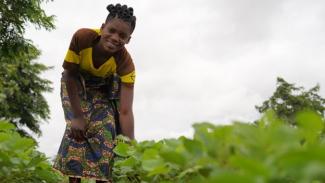Fatinesi Beliyamu is a 23-year-old farmer living in Kasiya, a rural community in central Malawi. Five years ago, Fatinesi dropped out of school because she was unable to afford the school’s fees. Since then, she has farmed one-and-a-half acres of land with a combination of soybean—which she sells for income, and maize—which she grows for her own consumption. Despite all her work, Fatinesi has not been able to produce enough to feed herself, let alone surplus that she could sell to support other income-generating activities.
“In a good season, I could harvest 300 kilograms of maize and 100 kilograms of soybean. It was very hard to sustain myself with the little amount of soybeans that grew.”
One reason that Fatinesi’s yields were so low is that she was unable to afford high-quality farming inputs. Fatinesi was planting recycled seed—grain saved from the previous year’s harvest—which produces lower yields and lacks the disease resistance of newer varieties. Without the financial capacity to invest in productivity enhancing inputs like fertilizers and certified seed, Fatinesi was locked in a vicious cycle of unproductivity and poverty.
As a young female farmer, Fatinesi bears the additional burden of existing in three uniquely marginalized demographics of the Malawi population. As a young person, she struggles to find economic opportunities, and as a smallholder farmer she lacks access to formal credit facilities. It is her identity as a woman, however, which poses the greatest challenge. Despite belonging to the population making up 80 percent of the Malawian agricultural labor force, women like Fatinesi are more likely to be poor, and have less access to agriculture inputs and credit than men.
Empowering women by providing access to affordable finance
This year has been particularly difficult for women like Fatinesi. Russia’s invasion of Ukraine in February of 2022 disrupted agricultural supply chains and drove up prices globally for fuel, fertilizers, and food. In Malawi, the price of the staple grain, maize, has more than doubled since last year, and in Fatinesi’s village, many households are choosing whether to eat lunch or dinner. Across the country, one in four Malawians (5.4 million people) are facing moderate or severe chronic food insecurity.
To ease the impact of the market shocks and supply chain disruptions, USAID provided $12 million in supplemental funding to help cushion the impacts of the war in Ukraine in Malawi. The funding was swiftly deployed to several interventions that tackle food insecurity, including an input loan program that helps farmers like Fatinesi to increase their food production by linking them with productivity-enhancing inputs such as certified seed, inoculant, and fertilizer.
The input loan program was developed in 2018 through USAID’s Feed the Future Malawi Agricultural Diversification Activity, in partnership with a local NGO called the Women’s Legal Resource Center (WOLREC). WOLREC adapts existing village savings and loan groups to deliver certified seed and inoculant to farmers, who repay the cost of the inputs plus ten percent interest, into a revolving fund after they harvest and sell their produce. Once they repay the loan, farmers use the fund to continue purchasing high-quality inputs annually.
Fatinesi is one of more than 100,000 Malawians who have been able to access farm inputs as a result of the supplemental funding. In November, she attended a financial literacy training with other members of her community during which WOLREC explained how the loan would work and provided training on how to approach farming as a business. Then, in early December, she collected a 25kg bag of certified soybean seed and 2 sachets of inoculant from a truck that came directly to her village center. By January, Fatinesi was proud to display a flourishing soybean crop.
“This loan has enabled me to not only produce using certified seed, but also to expand my production areas to a level that is hardly possible for many farmers in this area. Even though we have not yet harvested, looking at the crop, I am optimistic that I will harvest more than double what I’ve harvested in the past.”
Fatinesi is already looking forward to using the profits from her harvest to invest in more agricultural activities. With the proceeds from selling her soybeans, she plans to purchase a bike and cart so that she can aggregate produce in her community, and sell it at more profitable markets closer to town.

Lawrence Lazarus/Feed the Future Malawi Ag Diversification Activity
